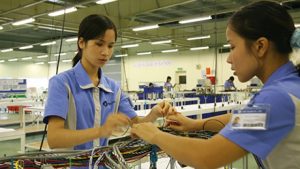Japanese manufacturers eye Vietnam as export base, Nikkei reports.

Recent survey reveals Vietnam, Indonesia and Thailand considered important investment destinations, while also finding China regaining favor.
Japanese manufacturers regard Southeast Asia as the most important region for their business but are wary about labor shortages and pollution, according to a recent survey by Japan’s Mizuho Research Institute revealed to Nikkei.
The survey was conducted in February on Japanese manufacturers capitalized at 10 million Japanese Yen ($90,000) or more. It received valid responses from 1,121 companies.
Thanks to their growing markets and lower production costs, three countries in ASEAN made the Top 3, with Thailand selected by 57.8 per cent of respondents, Vietnam by 50.2 per cent, and Indonesia by 43.9 per cent.
The survey also revealed concerns among Japanese manufacturers about investing in the three countries.
Regarding Vietnam, 25 per cent of respondents said the problem of environmental pollution, both air and water, would worsen. Indonesia also stood out in this area, with 27.8 per cent of respondents saying environmental problems will worsen in the near future.
As for Thailand, 21.4 per cent of respondents said the supply of blue-collar workers would worsen in the next two to three years.
Meanwhile, 17.3 per cent said the supply of management-level workers would shrink. Both figures exceeded the ratios of respondents who expected the labor-supply situation to improve.
Many manufacturers looking for lower-cost alternatives to China have also set up production facilities in Southeast Asia. This is sometimes referred to as the “China plus one” strategy.
However, the survey suggests that Japanese companies are turning their attention back to China.
When asked to name a candidate destination in which to relocate their current Chinese operations, 21.1 per cent named “somewhere in China (that is more cost-effective than the current location)”.
This is a big jump from the previous survey’s 9.7 per cent and likely reflects the bottoming out of the Chinese economic slowdown.
A recovering China puts pressure on Southeast Asian countries keen for more investment to tackle labor, environmental, and other issues that threaten to turn off foreign companies.